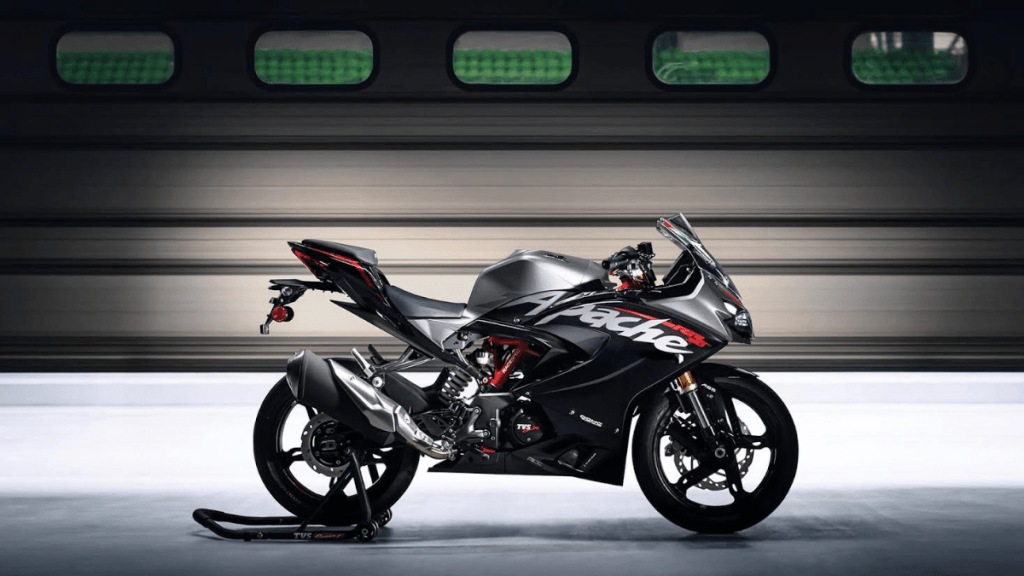TVS Motor Company, India’s third-largest motorcycle firm, has been unabashed about its premiumisation dream. Snapping up British motorcycle brand Norton Motorcycles was just one step in the premiumisation journey. In the company’s 2023-24 annual report, Managing Director Sudarshan Venu said, “We have outlined a product pipeline for FY2025-26, with additional time allocated for the development of high-quality products in the premium and super-premium segments.”
Over the past few years, TVS has shifted its product mix towards premium motorcycles. According to a report by Emkay Global Financial Services, the share of entry-level bikes in TVS’s overall sales volumes has dropped from 11.5% in FY20 to 8.5% in FY24. In contrast, the share of 125-cc bikes has seen a substantial increase, rising from 1.1% in FY20 to 11.8% in FY24, reflecting the company’s strategic focus on catering to the growing demand for higher-performance motorcycles.
As of now, TVS Motor offers two premium brands — Apache and Ronin — in the 160 cc to 310 cc displacement segments. The company is looking to support its upcoming premium line-up with merchandise, add-ons and customisations, besides rolling out community programmes to give competition like Royal Enfield a run for its money.
The question now is, how can TVS leverage its strategic alliances and experience to dominate this rapidly crowding premium segment?
Vimal Sumbly, head, premium business, TVS Motor, lists three things that the brand will bank on to cement its premium play — cutting-edge engineering, continuous innovation and focus on customer satisfaction. “Take our latest premium offering TVS Apache RTR 310… it introduces advanced features like cruise control, quickshifter, and climate control seating to elevate the riding experience,” he says.
The move towards higher CC motorcycles is a strategic one with significant potential, believes Aditya Singh Ratnu, co-founder of Zevo India. “Dominating the premium two-wheeler segment is an ambitious goal for every automotive brand,” he says. It is also in line with the changing dynamics of the two-wheeler market since the Covid pandemic. Once dominated by commuter vehicles in the 100-125-cc range, the focus has now moved to the 150-cc-plus segment, with the real action centered around bikes in the 300-400-cc range. Urban consumers are driving this change, seeking high-performance rides that offer both style and power. In response, every major player — be it TVS, Bajaj or Hero — has forged partnerships with global brands like BMW, Triumph, and Harley-Davidson to get battle-ready.
But entry-level bikes (76–100cc) still dominate the market with 51% share (2023), followed by commuter bikes (110–150cc) with 30%, and premium bikes (above 150 cc) with 18%.
Challenge & opportunity
There are two aspects to this focus on premiumisation — launching higher performance bikes while simultaneously sprucing up its global appeal, say experts. “This might involve the company concentrating more on showcasing the technical superiority, design ingenuity, and performance attributes of the more premium models,” says Abhishek Tiwari, global business head at NetSetGo Media. “There could also be a shift towards a more integrated worldwide branding approach in tune with international trends and consumer expectations.”
The key challenges for TVS would lie in overcoming the old perception of it being a mass brand, accelerating product development cycles and establishing an upscale distribution and after-sales experience, say experts.
“They need to cater to the entire segment of 300cc to 400cc users, which spans the cruiser segment, the cafe racers and sports naked bikes,” says automobile retail specialist Soumen Choudhury. “If you don’t have three or four models, it is not easy to be a player in that segment.”
Communication will be key in giving the brand an image makeover. “To cut through the clutter, TVS could try interactive and customised ad campaigns that engage customers at a deeper level. This may include AI-driven marketing that adapts content to personal tastes and AR experiences allowing potential buyers to virtually navigate their bikes,” says Tiwari. He advocates reaching out to social communities in niche markets by partnering with lifestyle influencers to woo luxury bike lovers and promote loyalty among them.
